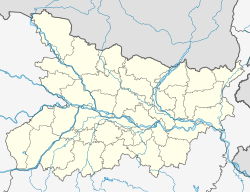Top Qs
Timeline
Chat
Perspective
Telhara, Nalanda district
Village in Bihar, India From Wikipedia, the free encyclopedia
Remove ads
Telhara is a village in Ekangarsarai block of Nalanda district, in Bihar. It is also the site of the Telhara monastery which dates back to the 1st-century CE.[1]
Remove ads
Buddhist monastery
Summarize
Perspective
Telhara was the site of a Buddhist monastery in ancient India. It has been mentioned as Teladhaka in the writings of the Chinese traveller Hiuen Tsang, who visited the place in the 7th century CE.[2] It is mentioned in an inscription found at Nālandā which mentions a temple restored a man named Bālāditya, a Jyāvisa of Telāḍhaka who had emigrated from Kauśāmbī, in the eleventh year of Mahipala Deva.[3]
It has been also mentioned in the Ain-i-Akbari as Tiladah, and is shown as one of the 46 mahals (administrative units) of the Bihar sarkar. Telhara was shown as a pargana in the maps prepared by the East India Company administration during 1842–45.[4]
The ruins of Telhara were mentioned in an 1872 letter by A. M. Broadley, the then Magistrate of Nalanda. Broadley noted that a large number of stone and metal images were often found during the digging of graves at the top of one of the mounds. Metal images found were melted down.[5] The State Government of Bihar started a new archaeological excavation of the site in December 2009, and later by the Bihar Heritage Development Society in 2020-2022. The work unearthed ancient pottery, antiques, and the remains of a three-storeyed structure mentioned by Xuanzang. Evidence of prayer halls and residential cells in the monastery has been found. The excavation revealed the following chronological layers:[6]

- Northern Black Polished Ware (circa 6th century BCE to 2nd Century BCE)
- Kushan (2nd Century BCE to 4th century CE)
- Gupta (4th to 6th century CE)
- Early Medieval (mid 6th century CE to 13th century CE )
- Medieval (13th century CE to mid-18th century CE )
- Colonial (18th century to mid-20th century CE)
A number of sculptures from the site had been moved to museums during the British Raj. The Indian Museum in Kolkata houses the Maitreya and the twelve-armed Avalokiteswar images from Telhara. A Pala sculpture from the site is present at the Rietberg Museum in Zurich. Telhara has a mosque, which is said to have been built with the materials carried from the ruins of the Buddhist monastery.[4] One pillar contained an inscription that mentions the place-name Telāḍhaka.
Remains of an ancient university (Mahavihara) on the site were unearthed in 2014.[7][8]
A state Museum is being established to store the artifacts found.
Remove ads
Administration
Telhara comes under the administration of the Ekangarsarai gram panchayat. There are 5 census villages in the Telhara area:[9]
- Hajipur
- Khajepura
- Rasulpur
- Telhara
- Telhara Sani
References
External links
Wikiwand - on
Seamless Wikipedia browsing. On steroids.
Remove ads
